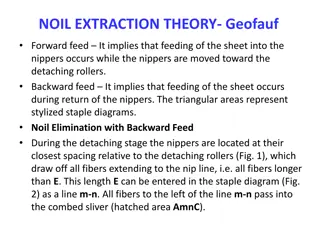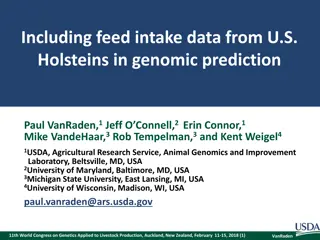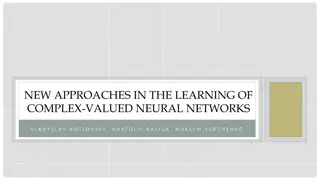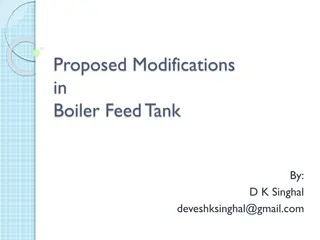Computational Physics (Lecture 18)
Neural networks explained with the example of feedforward vs. recurrent networks. Feedforward networks propagate data, while recurrent models allow loops for cascade effects. Recurrent networks are less influential but closer to the brain's function. Introduction to handwritten digit classification
0 views • 55 slides
Evolution and Potential of 5G Technology
Explore the evolving landscape of 5G technology, from enhanced mobile broadband to groundbreaking use cases and standalone networks. Learn how supportive regulations and spectrum allocation are vital for unlocking 5G's full potential. Discover the transformative impact of Standalone 5G networks on i
8 views • 10 slides
Feed Software Market
Feed Software Market by Type (Feed Formulation, Animal Simulation Model), Deployment Mode (On-premise, Cloud-based Software), Animal Type (Poultry, Ruminants, Aquaculture, Pet), End User (Feed Manufacturers, Animal Farmers) - Global Forecast to 2030\n
0 views • 2 slides
Introduction to Deep Learning: Neural Networks and Multilayer Perceptrons
Explore the fundamentals of neural networks, including artificial neurons and activation functions, in the context of deep learning. Learn about multilayer perceptrons and their role in forming decision regions for classification tasks. Understand forward propagation and backpropagation as essential
3 views • 74 slides
Understanding Computer Networks: Types and Characteristics
In the realm of computer networks, nodes share resources through digital telecommunications networks. These networks enable lightning-fast data exchange and boast attributes like speed, accuracy, diligence, versatility, and vast storage capabilities. Additionally, various types of networks exist tod
9 views • 12 slides
Feed Software Market is expected to reach $456.1 million by 2030
The growth of this market is attributed to the adoption of digital technologies and automation in the animal feed industry, the growing animal population, increasing demand for healthy animal-based food products, increasing animal health expenditure and pet insurance, and the growing need to reduce
0 views • 4 slides
Graph Neural Networks
Graph Neural Networks (GNNs) are a versatile form of neural networks that encompass various network architectures like NNs, CNNs, and RNNs, as well as unsupervised learning models such as RBM and DBNs. They find applications in diverse fields such as object detection, machine translation, and drug d
2 views • 48 slides
How to Resolve QuickBooks Bank Feed Issues_ A Comprehensive Guide
Resolve QuickBooks Bank Feed issues effortlessly with our expert guide. Learn step-by-step solutions to tackle common problems such as missing transactions, connection errors, and incorrect data imports. Whether you're using QuickBooks Desktop or Online, our comprehensive resource covers everything
2 views • 4 slides
Understanding Artificial Neural Networks From Scratch
Learn how to build artificial neural networks from scratch, focusing on multi-level feedforward networks like multi-level perceptrons. Discover how neural networks function, including training large networks in parallel and distributed systems, and grasp concepts such as learning non-linear function
1 views • 33 slides
Understanding Back-Propagation Algorithm in Neural Networks
Artificial Neural Networks aim to mimic brain processing. Back-propagation is a key method to train these networks, optimizing weights to minimize loss. Multi-layer networks enable learning complex patterns by creating internal representations. Historical background traces the development from early
1 views • 24 slides
Exploring Samsung SmartThings Hub and Zigbee/Zwave Networks
The Samsung SmartThings hub is a versatile device connecting Zigbee and Zwave networks, offering secure access to SkySpark via HTTPS. Zigbee and Zwave networks operate on distinct frequencies, enabling efficient communication without interference with WiFi. These networks support various devices for
0 views • 19 slides
Noil Extraction Theory: Geofauf Forward and Backward Feed Methods
Noil extraction theory involves Geofauf forward and backward feed methods for processing fibers in textile manufacturing. Forward feed involves feeding the sheet into the nippers while moving towards the detaching rollers, while backward feed feeds the sheet during the nippers' return. The process i
0 views • 6 slides
Understanding Friction Spinning Process and Technologies
Friction spinning is a textile manufacturing process that involves opening, accelerating, collecting, twisting, and winding fibers to create yarn. This process includes operations like fiber strand opening, acceleration, and collecting into a new strand, followed by imparting strength through twisti
1 views • 29 slides
Understanding Interconnection Networks in Multiprocessor Systems
Interconnection networks are essential in multiprocessor systems, linking processing elements, memory modules, and I/O units. They enable data exchange between processors and memory units, determining system performance. Fully connected interconnection networks offer high reliability but require ext
1 views • 19 slides
Introduction to Neural Networks in IBM SPSS Modeler 14.2
This presentation provides an introduction to neural networks in IBM SPSS Modeler 14.2. It covers the concepts of directed data mining using neural networks, the structure of neural networks, terms associated with neural networks, and the process of inputs and outputs in neural network models. The d
0 views • 18 slides
Overview of Neural Network Architectures for Machine Learning
This content provides an overview of feed-forward neural networks and recurrent networks, including their structures, functions, and applications in machine learning. It discusses the differences between the two architectures and their practical implications. Additionally, it highlights the challeng
0 views • 32 slides
Understanding Router Routing Tables in Computer Networks
Router routing tables are crucial for directing packets to their destination networks. These tables contain information on directly connected and remote networks, as well as default routes. Routers use this information to determine the best path for packet forwarding based on network/next hop associ
0 views • 48 slides
P-Rank: A Comprehensive Structural Similarity Measure over Information Networks
Analyzing the concept of structural similarity within Information Networks (INs), the study introduces P-Rank as a more advanced alternative to SimRank. By addressing the limitations of SimRank and offering a more efficient computational approach, P-Rank aims to provide a comprehensive measure of si
0 views • 17 slides
Phase Feed Forward System: Analyzing Beam Phase Stability and Theoretical Predictions
Exploring the impact of phase feed forward systems on beam phase stability through comparisons with theoretical predictions and simulations of increasing limitations. Testing the accuracy of theoretical gain factors and assessing performance using global gain factors. Utilizing specific data files a
0 views • 58 slides
Organic Feed Formulation Software: UBC Abacus for Pigs and Poultry
UBC Abacus is a software program developed at the University of British Columbia to assist farmers in formulating organic feed mixtures for poultry and pigs. It maximizes the use of home-grown ingredients, ensures nutrient needs are met, and promotes sustainability by providing on-farm control over
0 views • 22 slides
Enhancing Feed Safety Through GMP+ International Certification
Explore the world of GMP+ International certification for feed safety, providing value to former foodstuffs. Learn how food companies can ensure safe feed practices, with a focus on compliance, incident management, and traceability. Discover the chain approach in various industries, from cultivation
0 views • 12 slides
Global Animal Feed Market to Surpass $1 Trillion by 2031,
Animal Feed Market Size, Share, Forecast, & Trends Analysis by Type (Compound Feed, Roughages), Source (Plant, Animal, Novel), Form (Dry (Pellets), Wet), Animal Type (Poultry, Ruminants (Beef, Dairy Cattle), Swine, Aquaculture) - Global Forecast to 2
0 views • 5 slides
Unveiling the Feed Corpus: A Comprehensive Study
Explore how the Feed Corpus tackles the challenge of monitoring language evolution over time by discovering, validating, and scheduling feeds from sources like Twitter. The methodology involves linguistic processing, de-duplication, and more to build an ever-growing, up-to-date database. Witness the
0 views • 15 slides
Understanding Neural Network Learning and Perceptrons
Explore the world of neural network learning, including topics like support vector machines, unsupervised learning, and the use of feed-forward perceptrons. Dive into the concepts of gradient descent and how it helps in minimizing errors in neural networks. Visualize the process through graphical ex
0 views • 54 slides
Understanding Overlay Networks and Distributed Hash Tables
Overlay networks are logical networks built on top of lower-layer networks, allowing for efficient data lookup and reliable communication. They come in unstructured and structured forms, with examples like Gnutella and BitTorrent. Distributed Hash Tables (DHTs) are used in real-world applications li
0 views • 45 slides
Understanding Networks: An Introduction to the World of Connections
Networks define the structure of interactions between agents, portraying relationships as ties or links. Various examples such as the 9/11 terrorists network, international trade network, biological networks, and historical marriage alliances in Florence illustrate the power dynamics within differen
0 views • 46 slides
Efficient Animal Feed Log Grid for Easy Record Keeping
Simplify your animal feed logging process with the user-friendly Feed Log Grid. Easily track different types of food, quantities offered and consumed, and energy content. Learn how to complete the grid, make calculations, save and repeat entries, clone selected data, and efficiently display and expo
0 views • 11 slides
Genomic Prediction of Feed Intake in U.S. Holsteins
This study discusses the inclusion of feed intake data from U.S. Holsteins in genomic prediction, focusing on residual feed intake (RFI) as a new trait. The research involves data from research herds and genotypes of cows, with genetic evaluation models and genomic evaluation for predicting feed int
0 views • 17 slides
Sheep and Feed Value Chain Analysis in the Central Highlands of Ethiopia
Smallholder farmers in the central highlands of Ethiopia rely on sheep for both subsistence and income generation. This study analyzed the sheep and feed value chain, identified market dynamics, and assessed constraints and opportunities. The research area, methodology, results, and key actors in th
0 views • 15 slides
Understanding Network Analysis: Whole Networks vs. Ego Networks
Explore the differences between Whole Networks and Ego Networks in social network analysis. Whole Networks provide comprehensive information about all nodes and links, enabling the computation of network-level statistics. On the other hand, Ego Networks focus on a sample of nodes, limiting the abili
0 views • 31 slides
Tomato Pomace as an Alternative Feed for Poultry in India
Tomato pomace is explored as a cost-effective alternative feed for poultry production in India due to the rising cost and scarcity of traditional feed ingredients. This waste product from the tomato industry shows promise in providing nutrition for poultry, addressing the challenges of feeding costs
0 views • 31 slides
Comparison of MPP-Dairy and Other Margin Risk Management Systems
MPP-Dairy enrollment does not impact using other risk management systems, with exceptions for Livestock Gross Margin for Dairy (LGM). You can still forward contract farm milk and purchase feed while using MPP-Dairy. Options-based strategies like Class III puts and feed-based calls can establish an I
0 views • 25 slides
Evolution of Networking: Embracing Software-Defined Networks
Embrace the future of networking by transitioning to Software-Defined Networks (SDN), overcoming drawbacks of current paradigms. Explore SDN's motivation, OpenFlow API, challenges, and use-cases. Compare the complexities of today's distributed, error-prone networks with the simplicity and efficiency
0 views • 36 slides
Understanding the Basics of Forward Passes in Football
In football, a forward pass is a crucial play that involves specific rules to determine legality. This includes when a passer is beyond the neutral zone, limitations on multiple forward passes, conditions for illegal forward passes, and eligibility rules for receivers. Knowing these fundamentals hel
0 views • 15 slides
New Approaches in Learning Complex-Valued Neural Networks
This study explores innovative methods in training complex-valued neural networks, including a model of complex-valued neurons, network architecture, error analysis, Adam optimizer, gradient calculation, and activation function selection. Simulation results compare real-valued and complex-valued net
0 views • 12 slides
Proposed Modifications in Boiler Feed Tank for Improved Efficiency
The proposed modifications in the boiler feed tank aim to enhance efficiency by utilizing two separate tanks for cold makeup water and hot condensate. This innovative approach addresses the limitations of existing large tanks, reducing energy losses and insulation costs. By incorporating a small hot
0 views • 15 slides
Global Animal Feed Market Forecast Key Trends Driving Growth and Innovations
Animal Feed Market Size, Share, Forecast, & Trends Analysis by Type (Compound Feed, Roughages), Source (Plant, Animal, Novel), Form (Dry (Pellets), Wet), Animal Type (Poultry, Ruminants (Beef, Dairy Cattle), Swine, Aquaculture) - Global Forecast to 2
0 views • 6 slides
Understanding Interconnection Networks in Embedded Computer Architecture
Explore the intricacies of interconnection networks in embedded computer architecture, covering topics such as connecting multiple processors, topologies, routing, deadlock, switching, and performance considerations. Learn about parallel computer systems, cache interconnections, network-on-chip, sha
0 views • 43 slides
Understanding Attention Mechanism in Neural Machine Translation
In neural machine translation, attention mechanisms allow selective encoding of information and adaptive decoding for accurate output generation. By learning to align and translate, attention models encode input sequences into vectors, focusing on relevant parts during decoding. Utilizing soft atten
0 views • 17 slides
Understanding Deep Generative Bayesian Networks in Machine Learning
Exploring the differences between Neural Networks and Bayesian Neural Networks, the advantages of the latter including robustness and adaptation capabilities, the Bayesian theory behind these networks, and insights into the comparison with regular neural network theory. Dive into the complexities, u
0 views • 22 slides







































